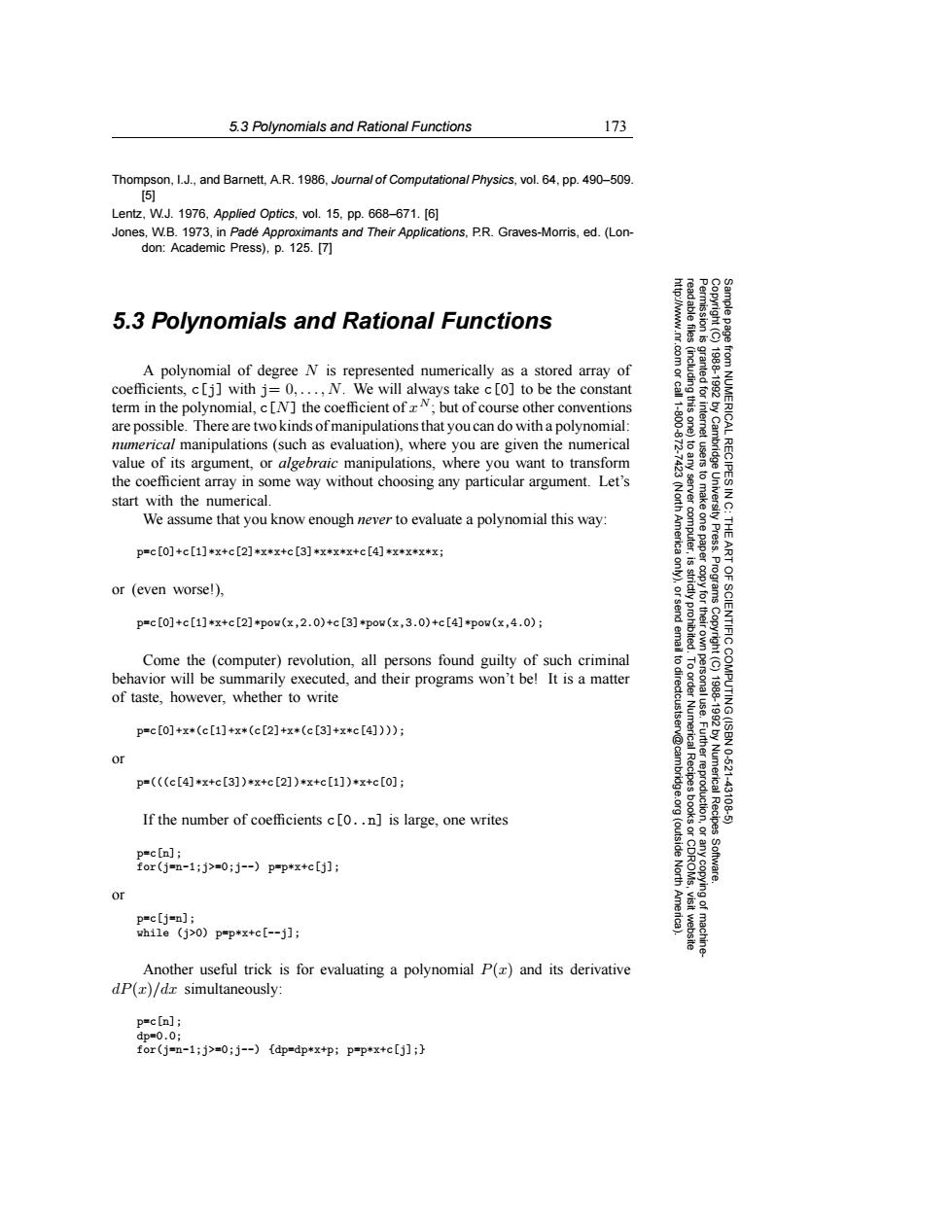正在加载图片...

5.3 Polynomials and Rational Functions 173 Thompson,I.J.,and Barnett,A.R.1986,Journal of Computationa/Physics,vol.64,pp.490-509. Lentz,W.J.1976,Applied Optics,vol.15,pp.668-671.[6] Jones,W.B.1973,in Pade Approximants and Their Applications,PR.Graves-Morris,ed.(Lon- don:Academic Press),p.125.[7] 5.3 Polynomials and Rational Functions A polynomial of degree N is represented numerically as a stored array of 83 coefficients,c[j]with j=0,...,N.We will always take c [o]to be the constant 鱼 18881892 term in the polynomial,c[N]the coefficient of N;but of course other conventions are possible.There are two kinds of manipulations that you can do with a polynomial: 100 numerical manipulations(such as evaluation),where you are given the numerical value of its argument,or algebraic manipulations,where you want to transform from NUMERICAL RECIPES I the coefficient array in some way without choosing any particular argument.Let's start with the numerical (Nort server We assume that you know enough never to evaluate a polynomial this way: America UnN电.t p=C[0]+c[1]*x+c[2]*x*x+c[3]*X*x*x+c[4]*x*X*x*x make one paper computer, ART or (even worse!). 9 Programs p=c[0]+c[1]*x+c[2]*pow(x,2.0)+c[3]*pow(x,3.0)+c[4]*pow(x,4.0); Come the (computer)revolution,all persons found guilty of such criminal behavior will be summarily executed,and their programs won't be!It is a matter of taste,however,whether to write OF SCIENTIFIC COMPUTING(ISBN p=c[0]+x*(c[1]+x*(c[2]+x*(c[3]+x*c[4])); or v@cambri 10-621 p=((c[4]*x+c[3])*x+c[2])x+c[1])*x+c[0]; 1988-1992 by Numerical Recipes 43108 If the number of coefficients c[o..n]is large,one writes 68i-450J-)Ppxtct: Software. or (outside North America). p=c[j=n]; while (j>0)p=p*x+c[--j]; Another useful trick is for evaluating a polynomial P(x)and its derivative dP(x)/dx simultaneously: p=c[n]; dp=0.0; for(j=n-1;j>=0;j--){dp=dp*x+p;p=p*x+c[j];}5.3 Polynomials and Rational Functions 173 Permission is granted for internet users to make one paper copy for their own personal use. Further reproduction, or any copyin Copyright (C) 1988-1992 by Cambridge University Press. Programs Copyright (C) 1988-1992 by Numerical Recipes Software. Sample page from NUMERICAL RECIPES IN C: THE ART OF SCIENTIFIC COMPUTING (ISBN 0-521-43108-5) g of machinereadable files (including this one) to any server computer, is strictly prohibited. To order Numerical Recipes books or CDROMs, visit website http://www.nr.com or call 1-800-872-7423 (North America only), or send email to directcustserv@cambridge.org (outside North America). Thompson, I.J., and Barnett, A.R. 1986, Journal of Computational Physics, vol. 64, pp. 490–509. [5] Lentz, W.J. 1976, Applied Optics, vol. 15, pp. 668–671. [6] Jones, W.B. 1973, in Pad´e Approximants and Their Applications, P.R. Graves-Morris, ed. (London: Academic Press), p. 125. [7] 5.3 Polynomials and Rational Functions A polynomial of degree N is represented numerically as a stored array of coefficients, c[j] with j= 0,...,N. We will always take c[0] to be the constant term in the polynomial, c[N] the coefficient of xN ; but of course other conventions are possible. There are two kinds of manipulations that you can do with a polynomial: numerical manipulations (such as evaluation), where you are given the numerical value of its argument, or algebraic manipulations, where you want to transform the coefficient array in some way without choosing any particular argument. Let’s start with the numerical. We assume that you know enough never to evaluate a polynomial this way: p=c[0]+c[1]*x+c[2]*x*x+c[3]*x*x*x+c[4]*x*x*x*x; or (even worse!), p=c[0]+c[1]*x+c[2]*pow(x,2.0)+c[3]*pow(x,3.0)+c[4]*pow(x,4.0); Come the (computer) revolution, all persons found guilty of such criminal behavior will be summarily executed, and their programs won’t be! It is a matter of taste, however, whether to write p=c[0]+x*(c[1]+x*(c[2]+x*(c[3]+x*c[4]))); or p=(((c[4]*x+c[3])*x+c[2])*x+c[1])*x+c[0]; If the number of coefficients c[0..n] is large, one writes p=c[n]; for(j=n-1;j>=0;j--) p=p*x+c[j]; or p=c[j=n]; while (j>0) p=p*x+c[--j]; Another useful trick is for evaluating a polynomial P(x) and its derivative dP(x)/dx simultaneously: p=c[n]; dp=0.0; for(j=n-1;j>=0;j--) {dp=dp*x+p; p=p*x+c[j];}